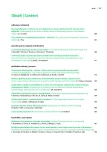Is functional dyspepsia really that frequent?
Authors:
Vít Navrátil; Pavol Dvoran; Vladimír ? Urana; Jiří Ehrmann; Vlastimil Procházka
Authors‘ workplace:
II. interní klinika – gastroenterologická a geriatrická LF UP a FN Olomouc
Published in:
Vnitř Lék 2018; 64(10): 903-910
Category:
Original Contributions
Overview
The literature shows, that the prevalence of functional dyspepsia is between 11 and 29.2 % in general population. The first goal of this study was to present a narrative review of the current findings of functional dyspepsia. The second goal was to find out the prevalence of functional dyspepsia in the II. Internal Clinic of Gastroenterology and Geriatry in Teaching Hospital of Olomouc (Czech Republic). According to the clinical experience, the prevalence of patients with functional dyspepsia seems to be not as high as literature shows. Normal gastroscopy findings are mandatory for the diagnosis of functional dyspepsia. That is why we examined 302 patients with indications for gastroscopy. According to the Rome IV criteria and normal gastroscopy findings, the diagnosis of functional dyspepsia was made only in 10 (3.31 %) patients. 108 patients have received repeated gastroscopy after 4 to 6 months period. But, none of them came with the diagnosis functional dyspepsia. Our results suggest, that the prevalence of functional dyspepsia after careful gastroscopic examination is lower than in the previous literature. This observation could change our view of functional dyspepsia and its diagnostics.
Keywords: functional dyspepsia – gastroscopy – prevalence – Rome IV criteria
Sources
- Ehrmann J. Funkční dyspepsie. Klin Farmakol Farm 2009; 23(1): 35–41.
- Rejchrt S, Koupil I, Kopáčová M et al. Prevalence and sociodemographic determinants of uninvestigated dyspepsia in the Czech Republic. Eur J Gastroenterol Hepatol 2008; 20(9): 898–905. Dostupné z DOI: <http://dx.doi.org/10.1097/MEG.0b013e3282fa7508>.
- Mahadeva S, Goh KL. Epidemiology of functional dyspepsia: A global perspective. World J Gastroenterol 2006; 12(17): 2661–2666.
- Ferreira-Maia AP, Matijasevich A, Wang YP. Epidemiology of functional gastrointestinal disorders in infants and toddlers: a systematic review. World J Gastroenterol 2016; 22(28): 6547–6558. Dostupné z DOI: <http://dx.doi.org/10.3748/wjg.v22.i28.6547>.
- Bureš J, Kopáčová M, Koupil I et al. Epidemiology of Helicobacter pylori infection in the Czech Republic. Helicobacter 2006; 11(1): 56–65. Dostupné z DOI: <http://dx.doi.org/10.1111/j.0083–8703.2006.00369.x>.
- Bureš J, Kopáčová M, Koupil I et al. Significant decrease in prevalence of Helicobacter pylori in the Czech Republic. World J Gastroenterol 2012; 18(32): 4412–4418. Dostupné z DOI: <http://dx.doi.org/10.3748/wjg.v18.i32.4412>.
- Mařatka Z. Functional gastrointestinal disorders–50 years’ experience in comparison with the Rome criteria. Folia Gastroenterol Hepatol 2005; 3(1): 10–16.
- Drossman DA. Functional gastrointestinal disorders: history, pathophysiology, clinical features, and Rome IV. Gastroenterol 2016; 150(6): 1262–1279. Dostupné z DOI: <http://dx.doi.org/10.1053/j.gastro.2016.02.032>.
- Drossman DA. The functional gastrointestinal disorders and the Rome III process. Gastroenterol 2006; 130(5): 1377–1390.
- Camilleri M. Peripheral mechanisms in irritable bowel syndrome. N Engl J Med 2012; 367(17): 1626–1635.Dostupné z DOI: <http://dx.doi.org/10.1056/NEJMra1207068>.
- Mayer EA, Gebhart GF. Basic and clinical aspects of visceral hyperalgesia. Gastroenterol 1994; 107(1): 271–293.
- Piche T. Tight junctions and IBS–the link between epithelial permeability, low-grade inflammation, and symptom generation? Neurogastroenterol Motil 2014; 26(3): 296–302. Dostupné z DOI: <http://dx.doi.org/10.1111/nmo.12315>.
- Mayer EA, Savidge T, Shulman RJ. Brain-gut microbiome interactions and functional bowel disorders. Gastroenterol 2014; 146(6): 1500–1512. Dostupné z DOI: <http://dx.doi.org/10.1053/j.gastro.2014.02.037>.
- Rajilic-Stojanovic M, Jonkers DM, Salonen A et al. Intestinal microbiota and diet in IBS: causes, consequences, or epiphenomena? Am J Gastroenterol 2015; 110(2): 278–287. Dostupné z DOI: <http://dx.doi.org/10.1038/ajg.2014.427>.
Labels
Diabetology Endocrinology Internal medicineArticle was published in
Internal Medicine

2018 Issue 10
Most read in this issue
- Treatment of polycythemia vera
- Fatty pancreas disease: clinical impact
- Weber-Christian disease: a case report
- Angiotensin-converting enzyme inhibitor-induced angioedema: epidemiology, pathogenesis and management
